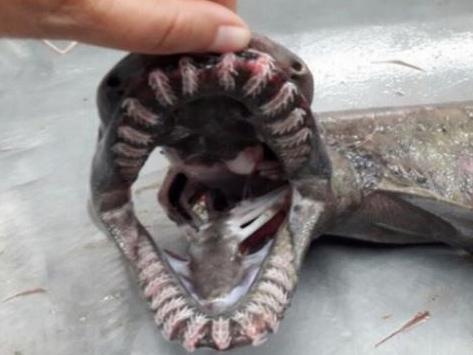Dinosaur-era shark with snake's head and 300 teeth found off Portuguese coast
Species dates back 80 million years

Your support helps us to tell the story
From reproductive rights to climate change to Big Tech, The Independent is on the ground when the story is developing. Whether it's investigating the financials of Elon Musk's pro-Trump PAC or producing our latest documentary, 'The A Word', which shines a light on the American women fighting for reproductive rights, we know how important it is to parse out the facts from the messaging.
At such a critical moment in US history, we need reporters on the ground. Your donation allows us to keep sending journalists to speak to both sides of the story.
The Independent is trusted by Americans across the entire political spectrum. And unlike many other quality news outlets, we choose not to lock Americans out of our reporting and analysis with paywalls. We believe quality journalism should be available to everyone, paid for by those who can afford it.
Your support makes all the difference.Scientists have discovered a dinosaur-era shark with 300 teeth and a snake’s head off the Portuguese coast.
The frilled shark was caught by a trawler during a research project on how to minimise unwanted catches during commercial fishing, according to Sic Noticias TV.
The rare species dates back 80 million years.
While its peers, such as the Tyrannosaurus rex and triceratops, died out long ago, this shark, with its frilled teeth and long, slim body still swims at great depths of at least 700 metres (2,300 feet).
Professor Margarida Castro of the University of the Algarve told Sic Noticias that the shark has 300 teeth, “which allows it to trap squid, fish and other sharks in sudden lunges”.
According to the Institute for the Sea and Atmosphere, the captured shark measured 1.5 m in length and was swimming off the Algarve coast.
The shark usually lives in the Atlantic and in waters near Australia, New Zealand and Japan, as reported by the BBC. At such depths the shark is in constant darkness, crushing pressure and extremely cold temperatures.
It is not known why this species has survived when other prehistoric creatures have not. It has also been speculated that the frilled shark influenced 19th century sailors’ stories of sea serpents.
Scientists have made other unusual discoveries in recent years including a long, toothy eel – likely a member of the snake-eel Opichthidae family – that was found washed up and decomposing on a Texas beach.
A man in Perth also recently found a sea squirt, or compound ascidian, resembling an animal’s tongue, but which acts as a colony for small animals called zooids which feed and live together.
International researchers pulled up a range of deep-sea creatures earlier this year off the coast of Australia, including the toothy “faceless fish”, a thorny red crab and a blue-eyed coffinfish that lures prey by dangling fluffy bait on top of its head.
Experts say more than 90 per cent of the world’s deep waters remain unexplored.
Join our commenting forum
Join thought-provoking conversations, follow other Independent readers and see their replies
Comments